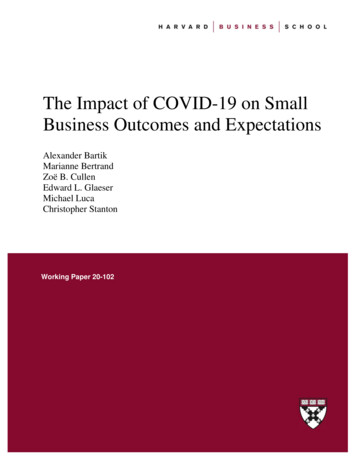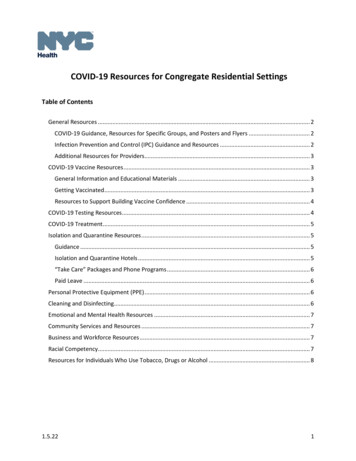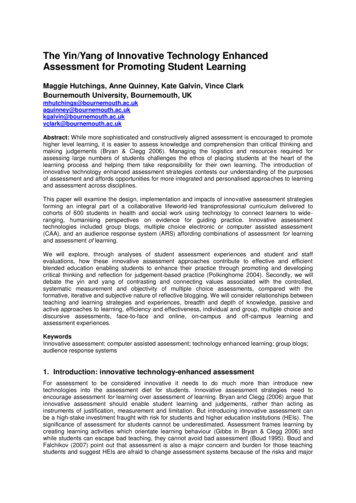
Transcription
IMPACT ASSESSMENT OF COVID-19 ON PAKISTAN’SMANUFACTURING FIRMSSURVEY RESULTS MAY-JUNE
AcknowledgmentsThis report was produced by the UNIDO Field Office in Pakistan with the support and technicalassistance of UNIDO’s Policy Research and Statistics Department and the Asia and the PacificRegional Coordination Division. Special thanks go to all ministries and associations thatsupported the implementation of the survey as well as to the respondents from the private sector,including micro, small, medium and large enterprises, who dedicated valuable time during thispandemic to contribute to the survey.DisclaimerThis report provides information about a situation that is rapidly evolving. As the circumstances andimpacts of the COVID-19 pandemic are continuously changing, the interpretation of the informationpresented here may also have to be adjusted in terms of relevance, accuracy and completeness.ii
Key Findingsi)The negative impact of COVID-19 on SMEs has been observed without exception,however, the density of the impact has varied across sectors, sub-sectors, business typesand firm size. At the highest level of segregation, the numbers show that agriculture wasthe least impacted with losses in revenue of between 10 per cent and 15 per cent;manufacturing lost revenue anywhere between 30 per cent and 50 per cent and services lostbetween 50 per cent and 70per cent in revenues compared to previous years.ii)More specifically, the survey shows that 90 per cent of all firms reported a negativeimpact on revenue due to COVID-19, while only 2 per cent reported an increase.Similarly, medium-sized firms, non-GVC exporting firms (these are also mostly mediumsized) and those with medium low-technology production lines were hit harder than largeor extremely small businesses. Exporters and GVC-linked firms expect a continued slowdown due to their dependence on global economies stabilizing and recovering from thepandemic. Women-led firms also experienced the strongest impact, with many smallmanufacturing firms being shut down completely during the lockdown period.Consequently, more than 50 per cent of firms expect layoffs, with medium firms reportingthe highest expected layoffs.iii)The government’s lockdown measures had a universal impact, with over 80 per cent offirms reporting to have been directly impacted. It is important to highlight that thegovernment never ordered a complete lockdown for the entire country, and essential sectorssuch as food, agriculture-related, pharmaceuticals or those with urgent active export orderswere given special permission to remain operational. This meant that some of the connectedindustries also remained operational, for example, the packaging industry remained openbecause the food industry relies on it.iv)Demand reduction has been one of the biggest impacts on firms. A reduction in ordershas led to decreased revenue flows. Additionally, most firms operate on a cash credit cyclewith vendors and distributors; the sudden lockdown has disrupted the cash credit cycle,leaving many firms absolutely dry. While firms have tried to obtain additional loans tocompensate for cashflow shortages, difficulties in obtaining loans have exacerbated thesituation. Cutting operational costs is another option firms have chosen. In addition, theyare concerned about payments to employees and social security contributions thatcontinued despite the lockdown. They are also concerned about the repayment of loans tocommercial banks.iii
v)The shortage of inputs, including raw materials, is also reported to be a serious problemfor firms, one of the consequences of the lockdown and other restrictions related to thepandemic. The containment measures have led to supply chain disruptions due tointernational border closures and restrictions to domestic movement. Interestingly, we findthat regardless of global value chain (GVC) involvement, domestic upstream anddownstream firms have faced nearly the same level of input shortages. This could implythat firms source raw materials both from abroad and from within the country. For example,lentils imported from Australia, palm oil from Malaysia and medicinal inputs from Italywere all impacted.vi)Extended containment measures such as restriction of movement worsen firms’ prospects.The majority of small-size firms and 44 per cent of domestic downstream firms expectto have to close down in less than three months should the containment measures beextended for a longer period.vii)The majority of firms across all sizes and types were able to easily meet the new safetymeasures and standard operating procedures (SOPs) introduced by the government. It must,however, be noted that firms have a bias towards reporting ease of meeting governmentstandards of compliance, as they feel this might impact the decision on extending thelockdown and lead to more stringent enforcements and inspections.viii) In addition to the quantitative survey, UNIDO Pakistan has been closely associated withthe surgical, garments, auto parts and footwear industries in Punjab Province under itscluster development programme, which is being implemented in cooperation with thegovernment.ix)The pandemic has potentially affected the targets of Sustainable Development Goal-9 oninclusive and sustainable industrial development (ISID), particularly those targets relatedto SDG-9, namely industry, innovation and infrastructure, i.e. specifically Targets 9.2, 9.3and 9.4, while Target 9.b could remain stagnant.Recommended policy options include job retention programmes, an extended period of taxexemption and loan deferrals, and tailored support programmes for micro and small firms.Applying UNIDO’s expertise in industrial development facility, manufacturing repurposingand adoption of the 4th Industrial Revolution (4IR) is also recommended. However, the priorityis to increase the predictability of government policy, build confidence in the economy andstimulate demand and production.iv
Table of Contents1Introduction . 12Method and data . 2342.1Online survey . 22.2Typology of firms. 32.3Respondent firms by type . 5Findings and analysis . 63.1Current impact of COVID-19. 63.2Expected impact of COVID-19 . 103.3Dealing with COVID-19 . 15Discussion . 234.15Inclusive and sustainable industrial development (ISID) – Sustainable Development Goal9 . 23Policy recommendations . 245.1Immediate or short-term measures . 245.2Short- to -medium-term measures . 255.3Medium- to long-term measures . 26References . 28Annex 1: Questionnaire . 29v
1IntroductionThe COVID-19 pandemic has buffeted economies and economic sectors across the globe withoutexception, with estimates that global GDP will contract by 5.2 per cent and the WTO predictinga decrease in global trade of up to 40 per cent. Pakistan’s situation does not differ, consideringthe country already had a weakened economy as reflected in its poor macro-economic indicatorsand low compliance with IMF conditionalities. The outbreak of the pandemic has been anadditional shock, slashing Pakistan’s expected GDP growth down to -0.38 per cent in 2020. Thisfigure compared to the original estimation of around 3 per cent GDP growth suggests thatPakistan’s economy will shrink by nearly 9 per cent in the last quarter of 2020, resulting inunemployment of3-4 million people.A nationwide lockdown was imposed in Pakistan in mid-April. In addition, the state closed allshops, restaurants and malls, including fitness and sport and leisure facilities. The governmentalso encouraged people to stay home to contain the spread of COVID-19. The containmentmeasures have been slightly eased since June. Shops, restaurants and malls have reopened withthe condition of having to adhere to the COVID-19 SOP and the new opening times from 9:00a.m. to 7:00 p.m.; all markets must remain closed on Saturday and Sunday. Certain businessesthat provide essential commodities such as pharmacies, hospitals, etc. were exceptions. The publicis advised to wear face masks at all times when moving outside of their residence.The COVID-19 pandemic is unprecedented and its impacts are looming large. According to theUnited Nations Pakistan’s ‘COVID-19 Socio-economic Impact Assessment and Response’report, the pandemic caused a deep contraction of the manufacturing sector in the first quarter of2020. All three key sectors, i.e. agriculture, industry and services, experienced economic lossesduring the first quarter of 2020. The pandemic has impacted the sectors unequally, however; theservices sector has been hit the hardest, followed by the manufacturing and the agriculture sector.Within the services sector, entertainment, hospitality, tourism and logistics have all sufferedsubstantial losses in revenue. Construction activities slowed down considerably in the first quarterof 2020, while the reduction in tourism negatively impacted accommodation and food serviceactivities, especially in the northern regions of Pakistan.UNIDO aims to investigate these sectors in more detail, in particular the manufacturing sector,and identify the impacts of the pandemic on firms, how they have been coping with the crisis, andthe types of support they have received so far. Additionally, we discuss to what extent theseimpacts have affected the country’s progress towards inclusive and sustainable industrialdevelopment as embedded in Sustainable Development Goal (SDG) 9 to build resilient1
infrastructure, promote inclusive and sustainable industrialization and foster innovation. Lastly,we offer some policy recommendations.Small- and medium-sized garments manufacturing firms witnessed a reduction in export ordersor shut down completely, resulting in a loss of revenue and employment. Similarly, the surgicalindustry is 100 per cent dependent on exports – the havoc the pandemic has created in Pakistan’smost relevant export markets means buyers were closed down and shipments either delayed orhalted altogether. The sector is also dependent on imported steel; the lockdown and generalslowdown has disrupted the supply of inputs. Moreover, firms reported that excessive costs havebeen incurred due to demurrage as shipments could not be cleared. Finally, the auto parts industryexperienced an extremely high demand shock as the economic slowdown has substantiallyreduced the sales of both new and used vehicles. The two auto giants in Pakistan, Honda andToyota, recorded historic lows in sales and their production has come to an absolute standstill formonths. This has had a trickle-down effect on auto parts manufacturers. The lockdown has alsoreduced vehicle usage, thus decreasing demand for repair and for auto parts. There were hardlyany accidents reported in Lahore during the lockdown period, for example. The major wholesalemarkets such as ‘Badami Bagh’ and others were also closed, resulting in a collapse of sales andpushing millions out of employment.This micro-level impact assessment serves as a baseline for UNIDO’s global assessment, whichwill be carried out at a later stage. UNIDO (the Department of Policy Research and Statisticstogether with the Country Office in Pakistan) has conducted similar assessments in other countriesin Asia including Cambodia, Lao PDR, Malaysia, Mongolia, Thailand and Viet Nam. As part ofits global assessment, UNIDO plans to conduct a similar exercise in these countries in comingmonths to investigate the development of the impacts and their situations over time.22.1Method and dataOnline surveyUNIDO launched an online survey for data collection from 15 April to 15 May 2020. Incollaboration with the Ministry of Industry and Production, Small and Medium EnterpriseDevelopment Authority (SMEDA) and UNIDO’s networks in Pakistan (such as project partnersand firms participating in UNIDO projects, Chambers of Commerce and Industry, etc.), the onlinesurvey was circulated to firms nationwide. Due to the unusual circumstances, the response rate tothe questionnaire was not as high as expected.2
The survey questionnaire was designed by UNIDO’s Department of Policy Research andStatistics and the Country Office in Pakistan based on the questionnaire on the Resilience ofMicro, Small and Medium Enterprises under COVID-19. The questionnaire contained 24questions consisting of four parts: i) current impact of COVID-19; ii) expected impacts ofCOVID-19; iii) dealing with COVID-19, including government support, and iv) generalinformation about respondent firms.2.2Typology of firmsIn our analysis, we separate the information into three categories:i)Firm size. Based on the definitions established by the SMEDA, SBP and FBR, ouranalysis classifies firms into small, medium and large.1ii)Engagement in global value chains (GVCs). We distinguish three types: GVC firms,domestic upstream and domestic downstream firms. “GVC firms” refers to firms that fallinto one of following categories: Producing intermediate inputs and selling a large share to foreign customers ordomestically located MNCs. Subsidiaries of MNCs with a large share of exports and/or imports. Two-way traders.“Domestic upstream” firms refers to non-GVC firms that sell intermediate goods,whereas “domestic downstream” firms are non-GVC firms that sell finished goods.iii)Firms’ level of technology. We group firms into: i) low-tech; ii) medium- to low-tech,and iii) medium- to high- and high-tech firms. Table 1 presents manufacturing industriesand their level of technology.1We use the universal definition of SMEs. Small firms are those with less than 50 employees. Medium firms are thosewith between 50 and 250 employees, and large firms have more than 250 employees.3
Table 1 Manufacturing industries and technology groupsAbbreviatiISIC codeon used inRevision 3this reportISIC full descriptionFood andbeveragesTobaccoFood and beveragesTobacco productsTextilesWearing apparel, and fur & leather products, and footwearWood products (excluding furniture)Paper and paper productsPrinting and publishingFurniture; manufacturing n.e.c.Coke, refined petroleum products, and nuclear fuelTextilesWearing18 & niture,n.e.c.Coke andrefinedpetroleumRubberand plasticRubber and plastic talsNon-metallic mineral productsBasic metalsFabricated metal productsChemicals and chemical productsChemicalsMachinery and equipment n.e.c. & office, accounting,computing machineryElectrical machinery and apparatus & radio, television, andcommunication equipmentMedical, precision and optical instrumentsMotor vehicles, trailers, semi-trailers & other transportequipmentn.e.c. not elsewhere classified.Technologygroup15 Low tech16 Low tech17 Low techLow tech20 Low tech21 Low tech22 Low tech36 Low 7MachineryMedium/highand29 & 30techequipmentElectricalmachineryMedium/high31 & techsMotorMedium/high34 & 35vehiclestechSource: UNIDO Industrial Statistics DatabaseAround 132 firms responded to the online survey, with 118 firms providing complete informationthat was used for analysis. Of the 132 firms, 22 per cent were small firms, 30 per cent weremedium and 48 per cent were large firms. The answers to some questions were not quantifiable.We only included valid responses that could be quantified and excluded those that could not bequantified, such as “don't know” or “too early to state”. The response rate is lower for thosequestions than the sample size of 132 firms. The response rate for such questions is specificallymentioned.4
Figure 12.3Responses by firm sizeRespondent firms by typeThe majority of responses (41 per cent) were provided by domestic firms engaged in global valuechains. Exporting firms accounted for 25 per cent and GVC firms for 34 per cent. Figure 1presents the data by firm type.Figure 2Responses by firm type5
33.1Findings and analysisCurrent impact of COVID-19a. Employees unable to work [Q.1]Fifty per cent of respondent firms reported that more than half of their employees were unableto come to work; the situation was worst for GVC firms.Figure 3Employees unable to workThere are several reasons presenting workers from returning to work. For example, in Sialkot, themajority of workers are piece rate workers and when the lockdown was imposed, these workersleft for their villages and may have gotten involved in agriculture and farm-related work. Astransport has remained closed as well, these workers had difficulties returning to their originalplaces of work. Moreover, due to uncertain income streams in an urban setting, the workers preferto remain in rural areas, where the living cost is low and some earnings are possible.b) Main financial problemsPayment of wages is the main challenge across firmsThe government’s lockdown decision severely disrupted firms’ cash cycles and resulted inliquidity problems. This caused financial distress for the majority of firms, which faceddifficulties meeting all of their regular payments. The most regular payment are workers’ salariesand the corresponding employee’s old age benefit institution (EOBI) and social securitypayments. Firms complained that they have been penalized rather than rewarded for retainingtheir workers (i.e. they have had to continue paying social security and EOBI contributions). This6
created undue pressure on firms that are facing tough circumstances. The payment of invoicesposed a problem as well, because firms were unable to realize their receivables due to disruptionsin the cash credit cycles. Payments were stuck across all supply chains. Firms that rely onimported inputs are facing maximum losses, for example, importers of raw materials for plasticwere hit particularly hard, because their funds were stuck in the market and shipments that landedat ports were accumulating demurrage while the price of materials dropped by more than half dueto reductions in prices related to petroleum products.Fixed costs, including rent, basic staff wages and utilities, continued accruing while firms had nosales and are struggling to make ends meet. This was more problematic for medium firms as theylacked the ‘muscle’ of large firms and flexibility of small firms.Figure 4Main financial problems7
c) Main business problemsNearly two-thirds of firms are facing lower demand, with foreign-oriented firms impacted themost.Figure 5Main business problemsA lack of demand in the market has been the biggest challenge firms have been facing. This hasbeen caused by the severe consumption shock linked to rapid unemployment, the decline inincomes, and the closure of businesses both globally and domestically. The surgical and garmentsindustries in Pakistan experienced a complete halt in orders from their European and UScustomers as most of the buying countries were under a strict lockdown. Similarly, the footwearindustry witnessed a sharp decline in local sales as all sale points were closed. Some of the moreprogressive footwear manufacturers moved to e-commerce, however, the basic infrastructure andsupport mechanisms for online sales are still very weak. Pakistan’s economy is still technologydeficient and digitally starved, which limits potential sales domestically. A shift to the digitalmarket place requires a different set of worker skills, sales systems, logistics management andwarehousing. Establishing such a network requires time. Auto sales hit a record low in Pakistanand during the last quarter of 2020, both Honda and Toyota shut down their plants for most of theperiod due to lack of demand, which has impacted the sale of spare parts and repairs andmaintenance. The data resonates these findings; all the secondary factors identified are stronglylinked to the core reason for the decrease in demand, resulting in or caused by logistics problems,financial difficulties and supply chain disruptions.8
d) Main operating problemsCashflow is the biggest concern of large firms, while small firms are more concerned aboutfulfilling contracts.The majority of supply chains in Pakistan eventually link up with the informal sector. This impliesthat apart from very large corporations, the supply chains of most businesses—regardless of theirsize—are linked with the cash economy at some stage. Most businesses make sales on creditwhere payments are realized with subsequent orders; the duration in the market depending onindustry can vary between 30 to 90 days. This credit sales model implies that by managing theperiod of credit sales, the same cash is being circulated in the market, therefore, at any one pointin time, only one of the market agents would actually be holding the cash. In a simple cycle,manufacturers sell to wholesalers on credit, who in turn sell to retailers, and once retailers makesales, the cash flows back. In March, the government was uncertain about imposing a lockdownand its message portended that a complete lockdown was not feasible. The provincialgovernments, however, imposed a strict lockdown without a grace period. This resulted indisruptions in the cash cycle. Retailers were left with unsold stock, hence they were unable tomake payments to wholesalers and wholesalers in turn were not able to pay factories which wereunable to pay for their inputs, especially imported materials lying at ports. This disruption createda severe liquidity problem in the markets and for manufacturers. This lack of cash, traderestrictions and disruptions in the flow of goods resulted in input shortages. The closure ofmarkets and lack of workers resulted in small firms not being able to deliver on theircommitments. This subsequent shortage resulted in price hikes of various inputs, creating furtherproblems within supply chains. The surgical industry, for example, is heavily reliant on importedsteel, which was not available due to the lockdown of ports; similarly, some firms in the cutleryindustry reported that they had to shut down individual factories as they were unable to fulfil theircommitments at the initially agreed prices.9
Figure 63.2Main operational problemsExpected impact of COVID-19The global economy is expected to contract by more than 5 per cent, and based on WTO estimates,world trade may fall by 40 per cent. This will have significant consequences for all economies,especially those that are more reliant on trade. However, this contraction also means that newopportunities will emerge as the world moves towards the ‘new normal’. Pakistan’s economygrew -0.38 per cent in the previous quarter of 2020, suggesting that the country’s economycontracted by more than 9 per cent; before the outbreak of the pandemic, Pakistan’s expectedgrowth rate was around 3 per cent. The economy is expected to grow by 1.5 per cent to 2 per centin 2021, though the rebound is somewhat slower than predicted for other South Asian countries,primarily due to the pre-COVID macroeconomic issues these economies faced.Unemployment is expected to increase by more than 3-4 million people based on research carriedout by the Pakistan Institute of Development Economics.2 Pakistan has been buffeted byeconomic headwinds from multiple directions: high levels of external debt with limited fiscalspace and the curtailing of public expenditure under the IMF restructuring plan had alreadyslowed down growth prior to the pandemic’s outbreak. With COVID, there is now an even largercontraction of production and exports, an almost full closure of the informal services economy,pressure on the weak health care system, loss of trade and tourism, dwindling remittances andsubdued investments. To make matters worse, a severe locust attack is threating food security 10
the country. Moreover, this bleak situation is subject to great uncertainty as expectations for thevirus caseload is still extremely high and if COVID-19 outbreaks persist, restrictions onmovement could be extended or reintroduced. Should such disruptions to economic activitycontinue, the impact on Pakistan’s economy will be even starker. This section provides asummarized analysis of firms’ perceptions of COVID-19’s impact on their revenues, employmentand other factors.e) Extreme losses in revenue are expected by most firms. Among the respondent firms, regardlessof their location, 90 per cent expected a more than 50 per cent loss in revenue in 2020. Out of 118respondent firms with valid responses, over half of the firms (56 per cent) located in provinceswith high infection rates, and 49 per cent of firms located outside of those provinces expected amore than 50 per cent decrease in revenue in 2020. Figure 7 illustrates these findings.Furthermore, we found that over 90 per cent of small-size and GVC firms anticipated a more than50 per cent decrease in revenue in 2020.Figure 7Impact on revenue11
f) Impact on revenueMedium- and GVC firms expect the biggest impact on their revenues.Figure 8Severity of expected decline in profitsg) Impact on employmentNearly 50 per cent of firms are currently considering layoffs.Layoffs were not a prioritized mitigation measure. On the bright side, regardless of firm type andsize, nearly 50 per cent of the 118 firms that provided valid responses did not consider laying offemployees. Small-size and domestic downstream firms were slightly less optimistic.12
Figure 9Impact on employmenth) Government restrictionsNearly 80 per cent of firms are affected by the current restrictions.Figure 10Impact of government restrictions on firms13
i) Expected survival with current restrictionsTwo-thirds of firms will have to close down within 3 months, small-size firms will be hit thehardest.Figure 11Expected survival of firmsj) Expected time to return to normal businessDomestic and larger firms are set to recover faster than others.Figure 12Expected time to return to normal business14
3.3Dealing with COVID-19k) Dealing with cashflow shortagesFirms are cutting operating costs and taking loansTo cope with cashflow shortages, firms are taking out loans and cutting operating costs. We foundthat regardless of firm size and type, 61 per cent of all respondent firms had chosen to take loansfrom commercial banks, while an average of 52 per cent had reduced their operating costs to dealwith the shortage of cashflow. Reductions in operating costs have meant that either staff were laidoff or were asked to work part time on rotation. Some firms event sent staff on forced unpaidleave.Figure 13l)Measures to deal with cash flow shortagesDealing with worker shortagesThe shortage of workers has led to delays in delivery and outsourcing for the majority of firms.15
Figure 14Measures to deal with worker shortagesm) Dealing with input shortagesInput shortages have led to a reduction of production and delays in delivery. Exporters have beenhit the hardest.Figure 15Measures to deal with input shortages16
n) Who is receiving government support?One-third of firms are receiving government support; support is higher for large firms.Figure 16Share of firms benefitting from government supportThe majority of firms are aware of the special loans being provided by the State Bank, thereductions in sales tax, especially in the case of Punjab, as well as the exemptions offered to theconstruction industry. Most SMEs were, however, excluded from these incentives as they did notqualify for the exemptions. For example, in Punjab Province, businesses reported some relief interms of sales tax, but those operating in industries that were still closed, such as the hospitalityindustry, were unable to benefit from such government support. Similarly, as restaurants wereonly operating as takeaways/deliveries, most of the payments were being made in cash, hence thereduced sales tax on card payments was negligible. Similarly, the majority of firms were awareof the State Bank’s reduced loan rates for salary payments, however, they complained that theamount of documentation required to benefit from the scheme represented a major barrier.Moreover, the SMEs asserted that anything short of interest-free loans would actually help. Firmsare only looking to survive and break even. The loans would be used to c
of 2020, while the reduction in tourism negatively impacted accommodation and food service activities, especially in the northern regions of Pakistan. UNIDO aims to investigate these sectors in more detail, in particular the manufacturing sector, . Toyota, recorded historic lows in sales and their production has come to an absolute standstill .











